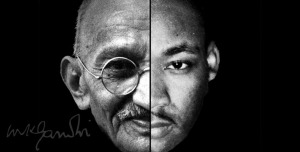
Mohandas Karamchand Gandhi was born on October 2nd, 1869, to Karamchand and Putlibai Gandhi. When Gandhi turned 18 he started studying in England to become a lawyer. After moving back to India in 1891, he was unable to find work, so in 1893, he moved to South Africa. During his time in South Africa, he began to develop the philosophy of non-violence. Gandhi used the act of Satyagraha or peaceful protest.It was there that Gandhi organized his first non-violent movement with the South African Indian community to oppose racist laws, putting his philosophy to use.
When Gandhi moved back to India in 1914, he found that the British had put the Rowlatt Acts in place, policies that allowed Indians who were suspected of sedition to be incarcerated without trial. He boycotted British goods and institutions. Even though he was arrested, after finishing his six-year sentence in jail, he resumed doing his non-violent advocacy work. By doing the Salt March, boycotting, and fasting, he changed the Indian governing system. It was later when he protested the discrimination of the "untouchables" (the lowest group of the Indian caste system) that he gained international media attention.
Martin Luther King Jr. was born on January 15, 1929, to Martin Luther King Sr, and Alberta Williams King. He came from a family of Baptist preachers. King first experienced racism when his white playmates told him that they couldn't play anymore and that they were moving to segregated schools. The summer before going into college, he spent some time in Connecticut and was surprised with how peaceful it was there. He graduated from Morehouse College with a degree in Sociology. King spent the next three years at the Crozer Theological Seminary at Chester, Pennsylvania.
King first encountered the idea of non-violence when he read, "A Theory of Civil Disobedience" by Henry David Thoreau while at Crozer. In the Fellowship House of Philadelphia, the preacher Johnson Mordecai Wyatts told King to study Gandhi's work. Gandhi's practices and work were of special interest to the progressive Black community. King was immediately intrigued and tried to get his hands on every book about Gandhi.
When Rosa Parks was arrested in 1955, King organized the Montgomery Bus Boycott along with many other civil rights leaders. It caused outrage within the white community. The grand jury convicted King and the leaders of the boycott because they broke the 1921 Anti-Boycott Act. In response, rather than waiting to get arrested, King's followers turned themselves in. When King spent two weeks in prison he was flooded with media attention.
Boycotting was one of many things that King borrowed from Gandhi. In 1959, King and his wife, Coretta Scott went to India. There they met the then Prime Minister, Jawaharlal Nehru and other Gandhi followers to learn more about Gandhi's methods. Back in the United States, King used methods similar to Gandhi. They both used Satyagraha by boycotting and doing peaceful marches such as the March on Washington and the Salt March. During their jail sentences, they both used that time to self reflect. They also used their trials for more publicity.
Gandhi and King undoubtedly have left a huge mark on history, not only because of their activism but also because of the way they fought for civil rights using non-violence.
[Sources:
Los Angles Review of Books
;
Martin King Jr. March and Education Institute
]

